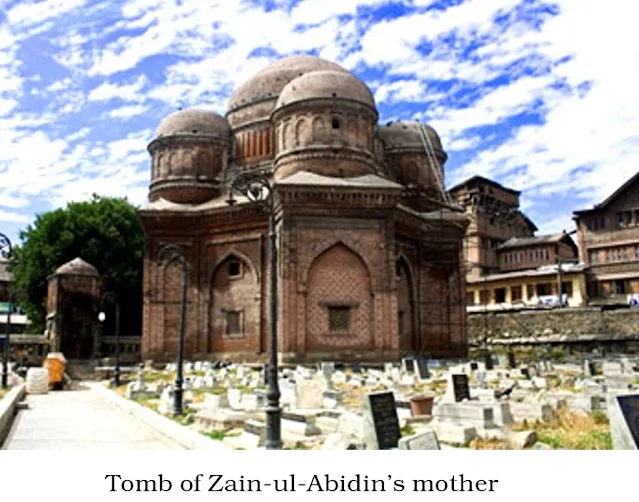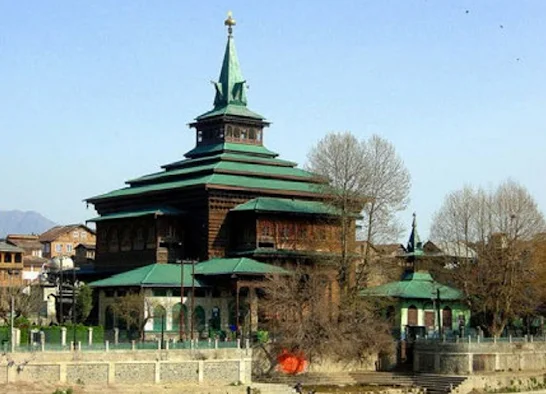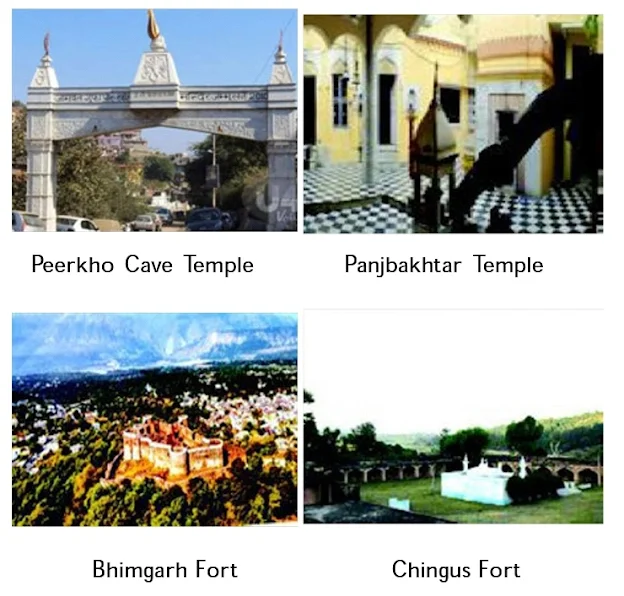MEDIEVAL HISTORY OF JAMMU & KASHMIR AND LADAKH
(Notes)
MEDIEVAL KASHMIR
Rinchana, a Ladakhi prince declared himself the ruler of Kashmir in 1320. He embraced Islam under the influence of Sayyid Sharif-u-Din, a Sufi saint, popularly know Balbul Shah, adopted the name Sadr-ud-Din and became the first Muslim Ruler of Kashmir. Following the death of Rinchana, his widow Kota Rani married Udayanadeva, who was declared as king. After the death of Udayanadeva, Kota Rani herself became the ruler. However, Shah Mir Defeated her in 1339 CE, and ascended the throne under the name of Sultan Shams-ud-Din Shahmir and laid foundation of Sultanate in Kashmir. The Shahmiri rule lasted upto 1540 CE. The illustrious ruler of Shahmiri dynasty was Zain-ul-Abidin (1420-1470 CE) popularly known as Budshah (the great Sultan).
Arts and Crafts
Zain-ul-Abidin revived the existing crafts and introduced some new ones including carpet weaving, paper making, book binding, silk weaving and paper machie. He invited experts from Central Asia and Persia to boost arts and crafts.
The names of the canals constructed by Zain-ul-Abidin:
- Kakapura Canal
- Chakdar Canal
- Awantipura Canal
- Mar Canal
- Krala Canal
- Lallkul Public
Public Works
He founded the towns of Zaina Nagar (Nau Shahr), Zainagir, Zainpur and Zainakot. He built the Khanqah of Sayyid Mohammad Madni at Srinagar. He laid out Rupa Lanka and Sona Lanka; the two man made Islands on Dal Lake besides Zaina Kadal bridge.
Literature
The Sultan patronised Srivara and Jonaraja who wrote Jaina Rajatarangni.Besides, Zaina Charitra and Zaina Villasa of Yodha Bhatta were written during this period. Rajatarangni of Kalhana was translated into Persian. Being a good poet sultan wrote a Persian poem, Shikayat.
Religious Tolerance
The Sultan is remembered for his policy of religious tolerance. He abolished Jaziya and the cremation tax and banned cow slaughter. He repaired Hindu temples and got some new ones built. However, the Sultan was a devoted Muslim in his personal life.
End of the Sultanate
Shahmiri dynasty reached the climax under Zain-ul-Abidin. But his death was followed by wars of succession, incompetent rulers, revolts and intrigues of king makers (nobles). Mirza Haider Dughlat, a cousin of Babar invaded Kashmir in 1540 AD and easily occupied it. He ruled upto 1551 AD, and was killed in action with local nobility.
Chak Rule
Ghazi Chak, Chief Minister of Sultan Habib Shah set aside the ruler and declared himself as the ruler, laying the foundation of Chak rule. Among the Chak rulers, Yousuf Shah Chak (1579-86 AD) was one of the most important rulers. (Yusuf Shah is immortalized in the songs of his supposed queen Haba Khatun). Almost the entire Chak period was marred by revolts, civil disturbances and internal feuds. This led to the Mughal occupation of Kashmir in 1586 AD by Akbar.
Mughal Rule in Kashmir
The Mughs ruled Kashmir for about 166 years (1586-1752 AD). They deputed Subedars to govern Kashmir. Mughal rule ushered an era of peace and security. The uniformity of administrative system, abolition of the toll tax, the hated forced labour (Begaar) was abolished, improvement and extension of routes boosted the trade, crafts and commerce of Kashmir. Scholars like Sheikh Yakoob Sarfi and Baba Dawood Khaki and poets like Ghani Kashmiri flourished during this time. The trade routes of Kashmir in addition to Mughal road and the Muzaffarabad-Pakhli route were Poonch route, Kishtwar route and Central Asian trade route.
Architecture
Qutabuddin built this mosque for the great saint, Shah-i- Hamdan RA.It was destroyed twice by fire in 1479 AD and 1731 AD, but was again reconstructed. The present Khanqah was built in 1732 AD by Abdul Barkat Khan.
Jamia Masjid Srinagar:
This grand mosque was built by Sultan Sikandar on the insistence of Mir Mohammad Hamdani RA during the period of five years from AD 1394-1400 AD. A distinguished architect of the period Syed Sadr-udin Khurasani supervised the construction. The mosque got burnt and was rebuilt by the respective rulers from time to time.
This grand mosque was built by Sultan Sikandar on the insistence of Mir Mohammad Hamdani RA during the period of five years from AD 1394-1400 AD. A distinguished architect of the period Syed Sadr-udin Khurasani supervised the construction. The mosque got burnt and was rebuilt by the respective rulers from time to time.
Hazratbal Shrine:The Mughal period is famous for the arrival of the Moi Muqadas (Hair of the Holy Prophet PBUH) in Kashmir. A Kashmiri trader Khawaja Nur-ud-Din Ishbari R.A brought this holy relic during the reign of Aurangzeb in 1699 AD, which was kept at the Khanqah of Bahauddin Naqashband RA for some time. It was finally placed in a mosque in Bagh-i-Sadiq Khan now known as Hazratbal.
Nagar Nagar City: Palaces, Barracks, houses constitute the well fortified and magnificent city around Hari Parbat. A strong stone wall was constructed around the city. The foundation of this fort was laid in 1597.
The Mughals Constructed Inns and Gardens in Kashmir:The first inn was built in 1597 AD at Khampora (Chadoora) and also at Send Brari. Besides these inns Mughals mostly developed gardens in Kashmir. The most prominent gardens constructed are Shalimar Bagh, Nishat Bagh, Chashme Shahi and Verinag.
Spread of Islam
Centuries prior to the establishment of the Sultanate in Kashmir in 1339, The discovery of a copy of Quran written by Fattu Allaha Kashmiri in 1237 AD bears testimony to a good Muslim presence prior to the establishment of Sultanate in Kashmir. However, the prominent Muslim missionary to arrive here was Sayyid Sharaf-u-ddin (RA), popularly known as Bulbul Shah. But the most prominent among the Sufi Missionaries was Mir Sayyid Ali Hamdhani (RA) who along with his companions visited Kashmir during the reign of Sultan Qutub-u-Din. The preachers reached the towns and villages of the state to live among the people and spread their faith. The influence of the Sufi saints and mystics like Sheikh Noor-u-Din Norani (RA) and Sheikh Hamza Makhdoom (RA) greatly contributed to spread Islam.
Afghan Rule in Kashmir
In the 18th century as the cental authority weakned, the governors in different regions began to assert their independence. The Mughal governor in Kashmir Abul Qasim Khan declared himself the independent ruler of Kashmir. Meanwhile, Ahmad Shah Abdali took full advantage of the disturbed and chaotic political situation of Kashmir. A large Afghan force defeated the Mughals and Kashmir came under the Afghan rule in 1753 AD. Ahmad Shah Abdali and his successors ruled Kashmir through the governors for a period of 67 years. It remained a part of Afghan kingdom upto 1819 AD. Kabul substituted Delhi as the center of authority for Kashmir.
Oppressive Taxation
Afghans imposed taxes on almost every commodity and every class of people. Haji Karimdad levied taxes like Zari Niyaz, on Mansabdars and Jagirdars, Zari-Ashkhas, on merchants and bankers, Zari-Hubab, a tax on grain, thus adding to the sufferings of the people. Dagi-i-Shawl, the department for taxing and stamping of Shawls levied an anna per rupee on the price of every piece of shawl from the shawl weavers. During the Afghan rule, the people were overburdened and they suffered economically due to the heavy taxation.
Some Afghan Governors of Kashmir were:
- Abdullah Khan Ashkaqsi,
- Noor-u-Din Bamzai,
- Atta Mohammad Khan,
- Ameer Khan,
- Jawan Sher,
- Raja Sukh Jeevan Mal,
- Sheikh Ghulam Mohi-u-din,
- Sheikh Imam Din.
Sikh Rule in Kashmir
After the death of Ahmad Shah Abdali in 1772, the Afghan rule weakened gradually. Maharaj Ranjit Singh who had invaded Kashmir in 1814 AD took full advantage of the situation and conquered Kashmir. He annexed it to Lahore Darbar in 1819 AD thus marking the beginning of Sikh rule that lasted up to 1846 AD.
Administration
To administer Kashmir, the province was divided into Paranganas. The Paraganas were divided into Zilas. The Sikh monarchs administered the province through a governor called Nazim. At the provincial level, Sahib-i-Kar supervised the revenue affairs. Qanungo looked after revenue collection in the Paraganas. Shiqdar, Sazawul, Muqqadam, Patwari and Tahwildar functioned at the village level. One-half of the produce was the state share.
Architecture under Afghan and Sikh Rule
The fort known as Qila Hariparbat was constructed by Afghan governor, Atta Mohammad, another fort at Shergari was constructed by Amir Khan Jawan Sher. The site is presently called the old secretariat in Srinagar. He also built Amira Kadel. It was swept away by the flood in 1836 AD and Mohan Singh got it rebuilt. Moreover, he linked the Anchar and Dal Lakes by canal which still bears his name as Nallah Amir Khan. Colonel Mehan Singh, the Sikh Governer built Basant Bagh and laid out localities of Guru Bazar and Shaheed Gunj.
MEDIEVAL JAMMU
Jammu region originally included only a small tract in the valleys of the Tawi and the Chenab in the outer hills and extending some way into the plains. The first historical mention of the region, under the name of Durgara occurs on two Chamba copper plates title deeds of the eleventh century. The name Jammu, first of all finds its mention in Malfuzat-i-Timuri.
Dev Dynasty
During the medieval period, Jammu was ruled by Dev dynasty. Suraj Dev (840-912 CE) was the first ruler of Dev dynasty. During this period, the capital of Jammu was Babbor. It has been mentioned as Babbapura in Rajatarangini.
- Malfuzat-i-Timuri is the autobiography of Timur.
- Timur was a Turco-Mongol ruler, who founded Timurid Empire in Persia and Central Asia.
- Rajatarangini is the celebrated history of Kashmir by Kalhana
Other notable rulers of Dev dynasty were Raja Mal Dev (1361-1400 CE), Raja Hamir Dev (1400-1423 CE), Raja Bhiram Dev (1454-1589 CE) and Maharaja Ranjit Dev (1733-1783 CE).
Timur’s Invasion
One of the significant events was the invasion of Timur in 1399 CE during the reign of Raja Mal Dev. Timur in his autobiography writes that the ruler of Jammu was not submissive to the Sultans of Delhi. He further mentions that Raja of Jammu submitted before him.
Mughal Conquest of Jammu
In the year 1588-89 CE, Jammu along with other hill states was conquered by the Mughal Emperor Akbar (1556-1605 CE) and were made tributaries. But Mughal authority sat very lightly on them and the rulers of Jammu were allowed to exercise the powers almost like an independent Sovereign. A yearly tribute called Nazrana was extracted from them. Some of the rulers of Jammu like Raja Sangram Dev (1594-1626 CE), Hari Dev and Gaje Singh (1692-1707 CE), 1656-1692 CE) were granted mansab or military rank in the Mughal army. They helped the Mughal emperors in their military expeditions.
Ranjit Dev
In the eighteenth century, with the decline of the Mughal empire, the Mughal hold over the hill principalities weakened. Raja Ranjit Dev of Jammu, who ascended the throne in 1733 CE, and became independent ruler in the region. He was the most notable chief who ever ruled in Jammu. Ranjit Dev was a man of great ability, and administrative talent. During Ranjit Dev’s reign, the town of Jammu prospered greatly. Ranjit Dev was known for his secular outlook. He accorded full religious freedom to all who took shelter in his territories.
Society and Culture
Position of Women: During the medieval period Sati and female infanticide were widely prevalent in Jammu. We get the references to Sati in the official records also. Although widow remarriage was prohibited but it was practised by the Manhas Clan of Rajputs and Jatts who called it Chaddar-dalna. Female infanticide was universal among the Rajputs. Purdha was also observed by the women of upper class but it was absent among the peasant women. In fact women played a very significant role in the economic life. Ranjit Dev tried to bring reforms in the society of Jammu and took certain initiatives for discouraging the social evils like Sati and female infanticide.
Literature
This period marks the growth of Sanskrit as well as Dogri literature in Jammu. Kavi Devi Dutt, Pandit Ganga Ram are some of the scholars who flourished in Jammu and produced literature in both languages. Kavi Devi Dutt wrote Vir Vilas, Bara-mah, Brajraj Panchasika and Krishna Mahima Stotra. Pandit Ganga Ram composed a popular poem in Dogri “Kandia da Basna” (Life in Kandi) besides, many other Sanskrit works.
Painting
This period is also remarkable for the development of Pahari school of painting.
Its main centres were at Basohli, Jammu, Guler, Kangra, Jasrota, and Mankot. These centres were particularly active from the later part of 17th century to the 19th century.
Its main centres were at Basohli, Jammu, Guler, Kangra, Jasrota, and Mankot. These centres were particularly active from the later part of 17th century to the 19th century.
Basohli Paintings
The most prominent was the Basohli school. Basohli school flourished under the patronage of Raja Kirpal Pal (1678-93 CE).
The Basohli style arose as a result of the marriage of the folk art of the hills with Mughal technique. The transparent drapery of women and clothes of men show the Mughal influence, while the facial formula is local with roots in the folk art of hills. The charm of the Basohli school lies in its colour appeal. Rich colours such as mustard yellows, burnt oranges, deep reds are used. The central inspiration of the Pahari school of painting, like other Rajput painting is Vaishvanism.
The Basohli style arose as a result of the marriage of the folk art of the hills with Mughal technique. The transparent drapery of women and clothes of men show the Mughal influence, while the facial formula is local with roots in the folk art of hills. The charm of the Basohli school lies in its colour appeal. Rich colours such as mustard yellows, burnt oranges, deep reds are used. The central inspiration of the Pahari school of painting, like other Rajput painting is Vaishvanism.
Architecture
A large number of monuments were erected at Basohli, Jammu and the regions around them during the early medieval and medieval period.
He donated land to a Buddhist monk Stag Tsang Raspo at Hemis, who constructed there, the famous Hemis monastery in 1630 AD. Sengge Namgyal built three Mani Walls in Ladakh and one in Zanskar. Besides, he built many chortens. Ladakh was also subject to the Mughals.
In the year, 1597 CE Ladakh and Baltistan were conquered by Mughal Emperor Akbar, who followed a conciliatory policy towards the chiefs of these districts. In the year 1632 AD, in the reign of Shahjahan, Ladakh was again conquered by Zafar Khan, the Mughal Governor of Kashmir. Zafar Khan captured the fort of Shigar and the ruler of Ladakh was forced to submit and to pay an indemnity of rupees one million. The reign of King Nyima Namgyal (1680-1720 AD) is significant in many aspects. During his reign, the art of printing was introduced in Ladakh from China and the blocks of six Lamaist books were engraved in Ladakh. Also during his reign, in the year 1751 AD, the Jesuit Desideri passed through Leh on his way to Lhasa and Nyima Namgyal was the first King, for a long time, under whom there was no warfare and peace and tranquility was established in Ladakh.
- A Chorten or Stupa is the Buddhist religious monument.
- Mani wall is a wall made of stone inscribed with a Lamaist prayer.
Socio Economic Conditions
For centuries, Ladakh had been an important centre of trade between India and Central Asia. The principal commodity of trade was wool. Kashmir received wool and leather from Ladakh and Baltistan. Other items of export were salt, dry fruits and Gold and the items of imports were grain, sugar, tobacco, etc. The game of Polo was introduced in Kashmir from Ladakh. Buddhism is the main religion of the people of Ladakh. Ladakh is known all over the world as the ‘Ancient Land of Buddhist Lamas.’ Christianity and Islam also made their appearance in Ladakh about 1100 and 600 years ago respectively. The town of Leh in Ladakh was the chief commercial depot of Kashmir’s import and export trade with Tibet, Turkistan and China. Buddhist monasteries in Ladakh are known as gumpas.











If you have any doubt, suggestion or question, feel free to contact us.